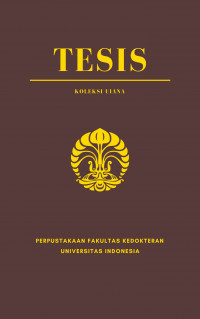Tesis
Hubungan Jam Terbang Total dan Faktor Lainnya dengan Hiperurisemia Pada Pilot Sipil di Indonesia = Relationship of Total Flight Hours and Other Factors with Hyperuricemia in Civil Pilots in Indonesia.
Latar Belakang : Dalam dunia penerbangan, selain memberikan dampak negatif pada kesehatan pilot, hiperurisemia juga dapat membahayakan keselamatan penerbangan melalui risiko inkapasitasi baik dikaitkan dengan peningkatan risiko terhadap penyakit kardiovaskular maupun dikaitkan dengan penyakit gout. Tujuan penelitian ini adalah diketahuinya prevalensi hiperurisemia pada pilot sipil di Indonesia dan identifikasi faktor-faktor risiko hiperurisemia terhadap pilot sipil di Indonesia. Metode : Penelitian menggunakan metode potong lintang dari rekam medis pilot sipil di Balai Kesehatan Penerbangan, Jakarta yang melakukan pemeriksaan 1 November 2019–30 April 2020. Data yang dikumpulkan dari rekam medis meliputi: data laboratorium asam urat dan kreatinin, usia, jam terbang total, IMT, konsumsi alkohol, dan riwayat penggunaan obat-obatan. Hiperurisemia adalah konsentrasi urat plasma lebih dari 7.0 mg/dl. Pengolahan data menggunakan aplikasi IBM® SPSS® Statistics Version 20. Hasil : Di antara 5399 pilot yang melakukan pemeriksaan kesehatan, sebanyak 194 merupakan kriteria eksklusi, sehingga jumlah sampel penelitian menjadi 5202 pilot; 18,4% memiliki kadar asam urat tinggi (hiperurisemia) dan 81,6% memiliki kadar asam urat normal. Pilot yang memiliki jam terbang total ≥ 5000 menurunkan risiko terjadinya hiperurisemia sebesar 24% dibandingkan pilot dengan total jam terbang < 5000 (OR 0,76 (95% IK 0,62-0,93); p=0,007). Pilot yang usianya ≥ 30 tahun menurunkan risiko hiperurisemia sebanyak 25% dibandingkan dengan pilot berusia < 30 tahun (OR 0,75 (95% IK 0,62-0,91); p=0,004). Pilot yang obesitas dan overweight memiliki risiko masing-masing 2,98 kali (OR 2,98 (95% IK 2,33-3,83); p < 0,001) dan 1,36 kali (OR 1,36 (95% IK 1,01-1,83); p=0,042) lebih besar mengalami hiperurisemia dibandingkan dengan pilot yang memiliki IMT normal. Selanjutnya jika dibandingkan pilot yang tidak mengkonsumsi alkohol, pilot yang mengkonsumsi alkohol memiliki risiko 14,68 kali lebih besar mengalami hiperurisemia (OR 14,68 (95% IK 9,35-23,06); p < 0,001). Kesimpulan : Prevalensi hiperurisemia pada pilot sipil di Indonesia sebesar 18,4%. IMT obesitas dan overweight serta konsumsi alkohol meningkatkan risiko terjadinya kondisi hiperurisemia pada pilot sipil di Indonesia.
Kata kunci : Hiperurisemia, jam terbang total, IMT, alkohol, pilot sipil, Indonesia.
Background : In the aviation world, in addition to having a negative impact on pilot health, hyperuricemia can also endanger flight safety through the risk of incapacitation either associated with an increased risk of cardiovascular disease or associated with gout. The purpose of this study is to determine the prevalence of hyperuricemia in civil pilots in Indonesia and identification of risk factors for hyperuricemia in civil pilots in Indonesia. Methods : The study used a cross-sectional method from the medical records of civil pilots at Aviation Medical Center, Jakarta which conducted an examination on 1 November 2019 – 30 April 2020. Data collected from medical records included: laboratory data of uric acid and creatinine, age, total flight hours, BMI, alcohol consumption, and history of drug use. Hyperuricemia is a plasma urate concentration of more than 7.0 mg/dl. Data processing using the IBM® SPSS® Statistics Version 20 application. Results : Of the 5399 pilots conducting medical examination, 194 were exclusion criteria, bringing the total sample of the study to 5202 pilots; 18.4% had high uric acid levels (hyperuricemia) and 81.6% had normal uric acid levels. Pilots who have total flight hours ≥ 5000 reduce the risk of hyperuricemia by 24% compared to pilots with total flight hours < 5000 (OR 0.76 (95% CI 0.62-0.93); p=0.007). Pilots aged ≥ 30 years reduced the risk of hyperuricemia by 25% compared with pilots aged < 30 years (OR 0.75 (95% CI 0.62-0.91); p =0.004). Obese and overweight pilots had a risk of 2,98 times (OR 2.98 (95% CI 2.33-3.83); p < 0.001) and 1.36 times (OR 1.36 (95% IK 1.011.83); p=0,042) greater experience hyperuricemia compared with pilots who have a normal BMI. Furthermore, compared to pilots who did not consume alcohol, pilots who consumed alcohol had a 14.68 times greater risk of developing hyperuricemia (OR 14.68 (95% CI 9.35-23.06); p < 0.001). Conclusion : The prevalence of hyperuricemia in civil pilots in Indonesia is 18.4%. BMI obesity and overweight and alcohol consumption increase the risk of hyperuricemia in civil pilots in Indonesia.
Key Word : Hyperuricemia, total flight hours, BMI, alcohol, civil pilots, Indonesia.
- Judul Seri
-
-
- Tahun Terbit
-
2020
- Pengarang
-
Simplisius Cornelis Tisera - Nama Orang
Dewi Sumaryani Soemarko - Nama Orang
Amilya Agustina - Nama Orang - No. Panggil
-
T20288fk
- Penerbit
- Jakarta : Program Studi Kedokteran Penerbangan., 2020
- Deskripsi Fisik
-
xiv, 48 hal; ill; 21 x 30 cm
- Bahasa
-
Indonesia
- ISBN/ISSN
-
-
- Klasifikasi
-
NONE
- Edisi
-
-
- Subjek
- Info Detail Spesifik
-
Tanpa Hardcopy
| T20288fk | T20288fk | Perpustakaan FKUI | Tersedia |


Masuk ke area anggota untuk memberikan review tentang koleksi